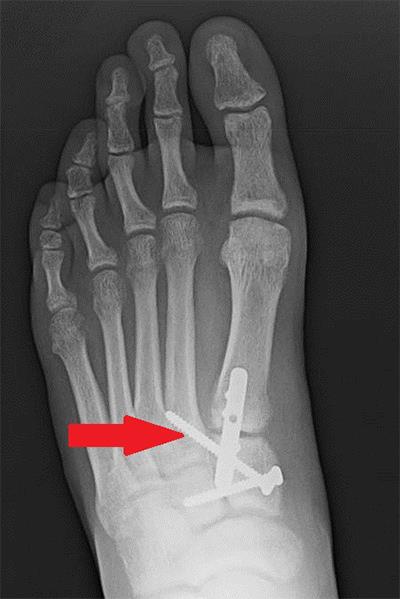The midfoot is the middle of the foot. It refers to the bones and joints that make up the arch and connect the forefoot (front of the foot including the bones of the toes) to the hindfoot (back of the foot including the ankle bone and the heel bone).
Midfoot Fusion
In a midfoot fusion, your foot and ankle orthopedic surgeon fuses together the different bones that make up the arch of the foot. Fusion eliminates the normal motion that occurs between two bones. Since there is very little movement in the small joints of the midfoot, the function of the foot can be preserved.
Midfoot fusion can involve all of the midfoot joints, but in most cases just one or a few of the joints are fused. The joints of the midfoot do not bend and move like your knee or elbow. They are designed to be relatively stiff to give your foot strength and support your body. Midfoot fusion generally does not produce much noticeable loss of motion because there is fairly little motion to begin with.
The primary goals of midfoot fusion are to decrease pain and improve function. This is achieved by eliminating the painful motion between arthritic joint surfaces and restoring the bones to their normal positions. Other goals include the correction of deformity, returned stability to the arch of the foot, and restored normal walking ability.
Diagnosis
The most common reason for midfoot fusion is painful arthritis in the midfoot joints that has not improved with non-surgical treatment. Other common reasons to do a midfoot fusion include too much motion of one or more of the midfoot joints or deformity of the midfoot. Examples of conditions that may result in midfoot deformity include severe bunions, flatfoot deformity, and arthritis. Midfoot fusion also is indicated for certain acute fractures and joint displacement involving the midfoot.
Midfoot fusion should not be performed if there is active infection or if the patient’s health is poor enough that the risk of surgery is too high. Conditions such as uncontrolled diabetes and blood circulation problems may make a patient a poor candidate for surgery. Other reasons to not perform midfoot fusion include osteoporosis and poor skin quality. Smoking significantly increases the risk that bones will not fuse.
Treatment
Successful midfoot fusion depends on complete removal of all joint surfaces (cartilage) and stable fixation of the joints being fused. Residual cartilage can prevent the bones from fusing together. Failure to achieve adequate stability may allow too much motion for fusion to occur.
Typically, your foot and ankle orthopedic surgeon will make one or two incisions on the top of the foot. The number and length of the incisions is determined by the number of joints to be fused. Your surgeon will pay careful attention to protecting tendons and nerves.
Stability is achieved during midfoot fusion using metal implants such as screws and plates. These are designed to immobilize the joints and allow for the formation of bone across the joint space. Your surgeon may add bone graft material to fill any gaps that might exist between the bones after the cartilage has been removed. This bone graft material may be taken from another location in the patient’s body (autograft). It may also come from donated bone (allograft) or from a synthetic material. A combination of these materials may be used.
Recovery
After surgery a period of protection and immobilization is required for successful fusion to occur. A cast is typically placed for the first 6-10 weeks. You will not be able to put weight on the affected foot for 6-12 weeks after surgery. X-rays usually are obtained every four weeks to assess progress of the fusion.
Gradually increased weightbearing is allowed as healing progresses. Initial weightbearing is protected in a prefabricated boot with gradual transition to supportive shoes. Physical therapy may be prescribed on a case-by-case basis to help the patient’s walking and balance.
Risks and Complications
All surgeries come with possible complications, including the risks associated with anesthesia, infection, damage to nerves and blood vessels, and bleeding or blood clots.
A major potential complication after midfoot fusion is failure of the bones to fuse (nonunion). Other complications can include over-correction or under-correction of deformity (malunion). There can be problems with wound healing. Prominent plates and screws can be painful and may require removal of the hardware. Injury to nerves on the top of the foot can occur.
Smoking is one of the leading risks for nonunion. Premature weightbearing can also result in failure of the bones to fuse.
FAQs
How much motion in my foot will I lose after midfoot fusion?
Motion of the midfoot joints is normally somewhat limited. Loss of that motion after fusion surgery tends to be well-tolerated by patients. The more mobile joints of the ankle, hindfoot, and forefoot are unaffected by midfoot fusion and thus continue to provide motion to the foot.
Will I set off an airport metal detector after midfoot fusion?
The strength of the metal detector and the amount of metal implants used determine whether hardware from a midfoot fusion will be detected. It is uncommon for the metal implants to be detectable by airport screening methods.
How will I get around after surgery before I am allowed to put any weight on the foot?
A combination of devices can be used, including crutches, walkers, knee-rollers, scooters, and wheelchairs. Physical therapy is used to help assess patient needs and improve mobility and safety. Certain patients may benefit from the assistance provided by a skilled nursing facility or post-operative rehabilitation unit.
Will the plates and screws have to be removed after midfoot fusion?
Metal implants used for midfoot fusion are not routinely removed. Hardware may need to be removed if there is a failure of the fusion or if infection develops. Painful hardware can be removed once the fusion is healed.


